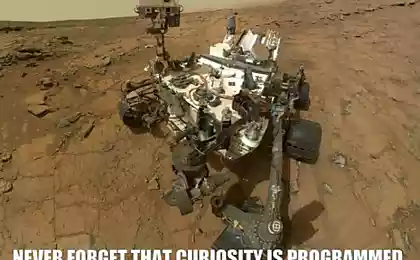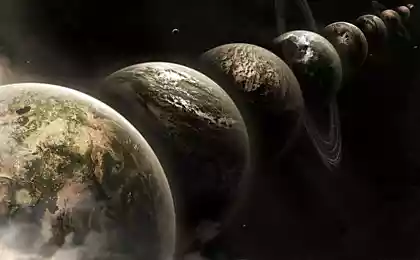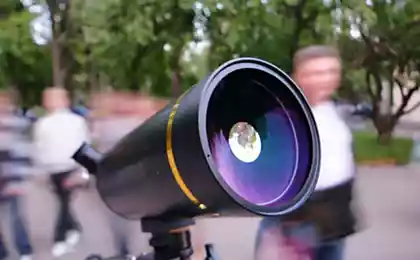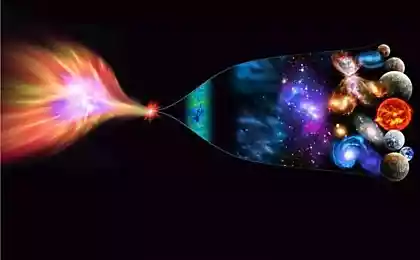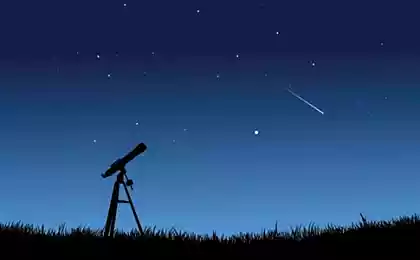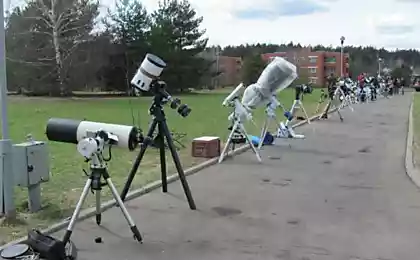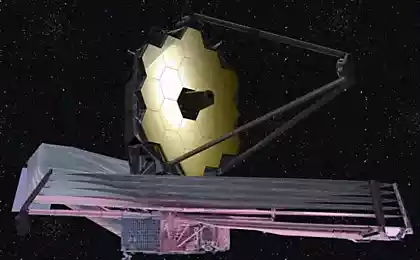536
"James Webb" is almost ready: NASA invites scientists to submit proposals for work with the telescope
Sixty two million eight hundred seventy thousand two hundred ninety seven
Almost immediately after the launch into orbit of the Hubble telescope, scientists began to prepare a more advanced device which was planned to equip a large number of features and capabilities. Now, almost twenty years later, this project has already been implemented, and the system has been tested and ready to work. We are talking about an orbital telescope "James Webb", which is equipped with a 6.5-meter mirror. This is two times greater than that of Hubble.
At the end of last year, scientific project Manager John Mather (John Mather) said that the telescope is ready and quite able to begin work in orbit. According to experts involved in the project, the new telescope will help to begin the study of galaxies that have been removed from the Earth at billions of light years. We are talking about the possibility to use a kind of time machine, observing the galaxies that appeared almost immediately after the Big Bang. This will help scientists to clarify the origin of the Universe.
Recent problems and their solution
Assembling of the main mirrors of the telescope was completed in February last year. Then the Agency NASA announced the successful installation of the last fragment. Each of the fragments of hexagonal shape with a mass of 40 kg has a diameter of about 1.3 m From the fragments and composed of a main mirror diameter of 6.5 meters. It is created from beryllium, which is coated with a gold film.
Fifty six million four hundred ninety nine thousand seven hundred forty five
Installation of mirrors were not a people, and a robot for this purpose was developed a special manipulator. On the mirror, except the mirror, scientists have found servos and spacers that adjust the curvature of the surface. According to experts, to ensure that focus was accurate, the fixture may not move more than 38 nanometers.
In November last year, scientists started to inspect the mirrors is a crucial step, which allowed to judge the health of the device. In tests, the experts simulated the external factors that could damage the structure. First of all, we are talking about the sound and vibration generated when starting the vehicle — these factors without proper attention it can bring the telescope down. Generally speaking, sending "James Webb" into orbit is a complex stage, during which it may be a lot of trouble if not managed carefully all the components of the submission process.
Twenty nine million three hundred fifty three thousand sixteen
"The test will show if there is any damage to the optical system after the test" — said at the time of the Ritva Keski-Kitchen (Ritva Keski-Kuha), head of testing telescope space flight Center name Goddard, NASA (Goddard Space Flight Center, GSFC).
To test was used the interferometer a device that allows to determine the characteristics of the telescope mirror with extremely high precision. The problem is that to test, you cannot directly contact with the mirror, all tests need to be performed remotely. Otherwise, the mirror may appear microcarpon, which will lead to decrease the efficiency of the whole system.
"Here's what we inspect — to know how things really are, instead of assume," said Deputy project Manager Paul Geithner (Geithner Paul).
The interferometer solves the problem. It allows you to record minute changes in the location of elements of a complex telescope mirror and the surface characteristics of individual fragments. The interferometer generates light waves of different lengths, the characteristics of which after reflection by a mirror are studied by experts.
"The previous four years can be called the preparation for the test," said in November last year, David Chaney, chief specialist on Metrology of mirrors in space flight Center Goddard. "We measure the size of the primary mirror, the radius of curvature of the background noise. Our test is so sensitive that we capture changes in the characteristics of the mirror even when people are talking in the room."
In November, the test went smoothly, no problems were detected. But in early December, the accelerometers that were attached to the telescope, I caught some anomalies during the passage of the vibrating tests. Scientists conducted low-level vibration tests, comparing the obtained data with those transmitted by the sensors to the appearance of anomalies. Once a problem was identified, the test is automatically stopped to protect the hardware. Scientists have studied once again studied the telescope, but found no abnormalities.
Thirty three million seventy nine thousand two hundred seven
In late December, NASA announced that the devices and other components of the system not found problems. Performed as a visual inspection and analysis of the images of the device in ultraviolet radiation. In addition, there were two additional low-level vibration tests, which also showed no problems with the telescope "James Webb". For more information about testing can be obtained from the document prepared by NASA.
In December John Mather announced that the project participants expect successful completion of the telescope all the required tests. The Agency plans to use any available precautions in order to ensure a successful withdrawal of the telescope into orbit. Yet, unfortunately, it is not clear what were the anomalies and how they can affect the system while sending it into space. The final conclusions will be formed by the Agency at the end of this month.
In the middle of this year "James Webb" will be sent to one of the branches of the company Northrop Grumman for final Assembly and connection with a sun screen, as well as a system for maneuvering in orbit. Prior to this, the optical system of the telescope and scientific instruments will be tested in the thermal vacuum chamber's Johnson Space Center.
While that program participants showed optimism. "We don't think that faced with something that would be difficult to fix," says Paul Hertz.
Astronomers can prepare their proposals for working with the telescope
229 meeting of the American astronomical community project representatives reported that scientists can begin to apply on the methods of operation of the telescope. Direct work of the telescope will begin in April 2019, six months after the planned launch of the system. Within six months, will be executed by different test procedures and check if all goes as planned, scientists will be able to implement their ideas.
"It amazes me," says Eric Smith, program Manager. The fact that over the years the team dealt exclusively with the technical side of things, not science. And now you go to the final stage and is engaged in scientific work. "This year gives the opportunity to the scientific community to get back to work on the program".
At the meeting, which was discussed above, program guide said that scientists who participated in the development of tools, software or various functions of the telescope "James Webb" will be able to get guaranteed time to operate the telescope. In addition, early access to the capabilities of the system will be given to those scientists who will offer interesting applications, giving you the ability to demonstrate full functionality of the telescope to the scientific community. As a result, other scientists will be able to understand how to best use the functionality of "James Webb" for observing the Universe, and send their own proposals. Anyway, that is the idea. "Normal" offers scientists will be able to send at the end of 2017.
But now the experts who participate in developing the system, continue testing of the telescope, including optical and scientific instruments. The tests are performed in the space flight Center name Goddard.
Seventy six million two hundred eighty one thousand eight hundred forty four
Components of the telescope and its capabilities
"James Webb" a very complex system, which consists of thousands of individual elements. They form a mirror telescope and its scientific instruments. Regarding the latter, such device:
According to Eric Smith, the project remains within budget. So far everything is going according to plan and there are no obstacles that would prevent you from starting the telescope in October 2018. The only observed problem vibration anomaly — already close to the resolution specialists are working actively to hold the final localization of the problem and to get rid of it. But, of course, difficulties can still arise. "Now we're at that stage of the program, when we are faced with new challenges, different from the problems that occurred until now," says Smith. But, at the same time, he is confident in the strength of the team "When problems arise, I am confident that the team can solve them."
Source: geektimes.ru/post/284434/
Almost immediately after the launch into orbit of the Hubble telescope, scientists began to prepare a more advanced device which was planned to equip a large number of features and capabilities. Now, almost twenty years later, this project has already been implemented, and the system has been tested and ready to work. We are talking about an orbital telescope "James Webb", which is equipped with a 6.5-meter mirror. This is two times greater than that of Hubble.
At the end of last year, scientific project Manager John Mather (John Mather) said that the telescope is ready and quite able to begin work in orbit. According to experts involved in the project, the new telescope will help to begin the study of galaxies that have been removed from the Earth at billions of light years. We are talking about the possibility to use a kind of time machine, observing the galaxies that appeared almost immediately after the Big Bang. This will help scientists to clarify the origin of the Universe.
Recent problems and their solution
Assembling of the main mirrors of the telescope was completed in February last year. Then the Agency NASA announced the successful installation of the last fragment. Each of the fragments of hexagonal shape with a mass of 40 kg has a diameter of about 1.3 m From the fragments and composed of a main mirror diameter of 6.5 meters. It is created from beryllium, which is coated with a gold film.
Fifty six million four hundred ninety nine thousand seven hundred forty five
Installation of mirrors were not a people, and a robot for this purpose was developed a special manipulator. On the mirror, except the mirror, scientists have found servos and spacers that adjust the curvature of the surface. According to experts, to ensure that focus was accurate, the fixture may not move more than 38 nanometers.
In November last year, scientists started to inspect the mirrors is a crucial step, which allowed to judge the health of the device. In tests, the experts simulated the external factors that could damage the structure. First of all, we are talking about the sound and vibration generated when starting the vehicle — these factors without proper attention it can bring the telescope down. Generally speaking, sending "James Webb" into orbit is a complex stage, during which it may be a lot of trouble if not managed carefully all the components of the submission process.
Twenty nine million three hundred fifty three thousand sixteen
"The test will show if there is any damage to the optical system after the test" — said at the time of the Ritva Keski-Kitchen (Ritva Keski-Kuha), head of testing telescope space flight Center name Goddard, NASA (Goddard Space Flight Center, GSFC).
To test was used the interferometer a device that allows to determine the characteristics of the telescope mirror with extremely high precision. The problem is that to test, you cannot directly contact with the mirror, all tests need to be performed remotely. Otherwise, the mirror may appear microcarpon, which will lead to decrease the efficiency of the whole system.
"Here's what we inspect — to know how things really are, instead of assume," said Deputy project Manager Paul Geithner (Geithner Paul).
The interferometer solves the problem. It allows you to record minute changes in the location of elements of a complex telescope mirror and the surface characteristics of individual fragments. The interferometer generates light waves of different lengths, the characteristics of which after reflection by a mirror are studied by experts.
"The previous four years can be called the preparation for the test," said in November last year, David Chaney, chief specialist on Metrology of mirrors in space flight Center Goddard. "We measure the size of the primary mirror, the radius of curvature of the background noise. Our test is so sensitive that we capture changes in the characteristics of the mirror even when people are talking in the room."
In November, the test went smoothly, no problems were detected. But in early December, the accelerometers that were attached to the telescope, I caught some anomalies during the passage of the vibrating tests. Scientists conducted low-level vibration tests, comparing the obtained data with those transmitted by the sensors to the appearance of anomalies. Once a problem was identified, the test is automatically stopped to protect the hardware. Scientists have studied once again studied the telescope, but found no abnormalities.
Thirty three million seventy nine thousand two hundred seven
In late December, NASA announced that the devices and other components of the system not found problems. Performed as a visual inspection and analysis of the images of the device in ultraviolet radiation. In addition, there were two additional low-level vibration tests, which also showed no problems with the telescope "James Webb". For more information about testing can be obtained from the document prepared by NASA.
In December John Mather announced that the project participants expect successful completion of the telescope all the required tests. The Agency plans to use any available precautions in order to ensure a successful withdrawal of the telescope into orbit. Yet, unfortunately, it is not clear what were the anomalies and how they can affect the system while sending it into space. The final conclusions will be formed by the Agency at the end of this month.
In the middle of this year "James Webb" will be sent to one of the branches of the company Northrop Grumman for final Assembly and connection with a sun screen, as well as a system for maneuvering in orbit. Prior to this, the optical system of the telescope and scientific instruments will be tested in the thermal vacuum chamber's Johnson Space Center.
While that program participants showed optimism. "We don't think that faced with something that would be difficult to fix," says Paul Hertz.
Astronomers can prepare their proposals for working with the telescope
229 meeting of the American astronomical community project representatives reported that scientists can begin to apply on the methods of operation of the telescope. Direct work of the telescope will begin in April 2019, six months after the planned launch of the system. Within six months, will be executed by different test procedures and check if all goes as planned, scientists will be able to implement their ideas.
"It amazes me," says Eric Smith, program Manager. The fact that over the years the team dealt exclusively with the technical side of things, not science. And now you go to the final stage and is engaged in scientific work. "This year gives the opportunity to the scientific community to get back to work on the program".
At the meeting, which was discussed above, program guide said that scientists who participated in the development of tools, software or various functions of the telescope "James Webb" will be able to get guaranteed time to operate the telescope. In addition, early access to the capabilities of the system will be given to those scientists who will offer interesting applications, giving you the ability to demonstrate full functionality of the telescope to the scientific community. As a result, other scientists will be able to understand how to best use the functionality of "James Webb" for observing the Universe, and send their own proposals. Anyway, that is the idea. "Normal" offers scientists will be able to send at the end of 2017.
But now the experts who participate in developing the system, continue testing of the telescope, including optical and scientific instruments. The tests are performed in the space flight Center name Goddard.
Seventy six million two hundred eighty one thousand eight hundred forty four
Components of the telescope and its capabilities
"James Webb" a very complex system, which consists of thousands of individual elements. They form a mirror telescope and its scientific instruments. Regarding the latter, such device:
- Camera near-infrared (Near-Infrared Camera);
- Device in the middle range of the infrared radiation (Mid-Infrared Instrument);
- Spectrograph near-infrared (Near-Infrared Spectrograph);
- Sensor-precise targeting c imager in the near infrared range and Besselian spectrograph (Fine Guidance Sensor/Near InfraRed Imager and Slitless Spectrograph).
- detection of light from the earliest stars and galaxies at the stage of their formation;
- the study of stellar populations in nearby galaxies;
- the study of young stars in the milky Way and Kuiper belt objects;
- determination of the morphology and colors of galaxies with a strong red shift;
- determination of light curves from distant supernovae;
- the creation of maps of dark matter using gravitational lensing;
- the detection of "first light»;
- the detection of exoplanets;
- obtaining their characteristics;
- transit spectroscopy.
According to Eric Smith, the project remains within budget. So far everything is going according to plan and there are no obstacles that would prevent you from starting the telescope in October 2018. The only observed problem vibration anomaly — already close to the resolution specialists are working actively to hold the final localization of the problem and to get rid of it. But, of course, difficulties can still arise. "Now we're at that stage of the program, when we are faced with new challenges, different from the problems that occurred until now," says Smith. But, at the same time, he is confident in the strength of the team "When problems arise, I am confident that the team can solve them."
Source: geektimes.ru/post/284434/
Google quietly listening to you through a microphone! Here's how to find your records...
RESENTMENT — Packed ANGER

